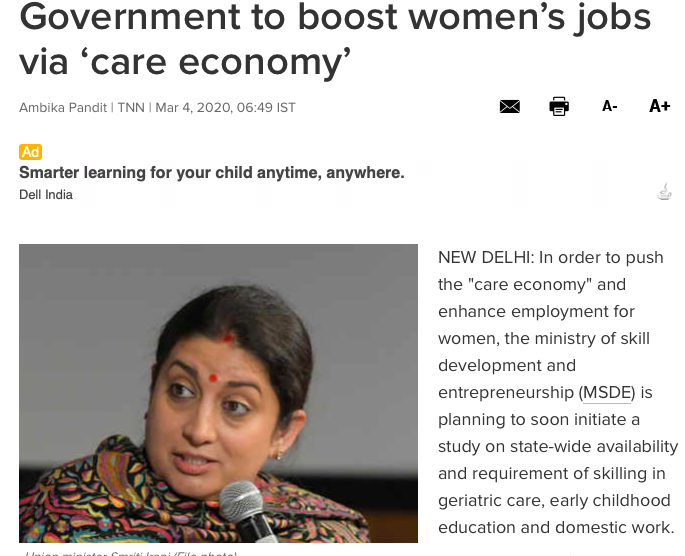Why Women Drive The Care Economy

Have you ever wondered why most of the teachers, nurses, domestic and Anganwadi workers are mostly women? All these job roles are a part of the care economy and the feminization rate of the total care workforce worldwide is 65.3 percent. The global care workforce consists of 381 million workers, out of which 248.9 million are women and 132.1 million are men. These figures convert into 11.5 percent of total global employment, 19.3 percent of global female employment, and 6.6 percent of global male employment. Care employment is, therefore, a significant source of employment throughout the world, in particular for women.
Before we delve into why most of the care work is done by women and its implication on the world of work and gender pay gap let’s understand what is care work and care economy.
Gender and Care: An overview and Data
Being caring is considered as a part of women’s DNA. However, if we look at the definition, there is no aspect of gender in the definition.
“Care” is defined as a process of protecting someone or something and providing what that person or thing needs.
The International Labour Organisation report on Care work and care jobs for the future of decent work defines care work and care economy using both the International Standard Classification of Occupations (ISCO 08 or previous versions) 9 and the International Standard Industrial Classification (ISIC Revision 4 or previous versions) as – a system that consists of activities and relationships involved in meeting the physical, emotional, and psychological aspects of care.
Care work can be direct or indirect, paid or unpaid, short-term (maternity needs) or long-term (care for the disabled and elderly). Direct care activities include activities such as feeding a baby or nursing an ill partner, and indirect care activities are activities like cooking and cleaning. Unpaid care work is care work provided without a monetary reward by unpaid carers. Unpaid care is considered as work as per ILO’s definition of work and is thus a crucial dimension of the world of work. Paid care work is performed for pay or profit by care workers. They comprise a wide range of personal service workers, such as nurses, teachers, doctors, and personal care workers. Domestic workers, who provide both direct and indirect care in households, are also part of the care workforce.
Despite the fact that all these care services are indispensable there are two major concerns that are ever-burgeoning when it comes to the care economy.
First, the massive gender gap with two-thirds of all care workers being women. Second, it involves a range of skills that are often not formally recognized or remunerated and working conditions that are not regulated. Care services are integral for existence but it is an undervalued component of economies all over the world.
Care workers include a wide range of workers who differ in terms of education, skills, sector and pay: from university professors, doctors, and dentists at one end of the spectrum, to childcare workers and personal care workers at the other.
Coming back to the statistics, women, and girls put in 12.5 billion hours of unpaid care work each and every day —a contribution to the global economy of at least $10.8 trillion a year. The 2019 ILO report ‘A Quantum Leap for Gender Equality’ identified unpaid care work as the biggest impediment to women’s formal employment, as it engaged 21.7 percent of women between 18-54 years of age, as opposed to 1.7 percent of men. Women make up 65 percent of the global care workforce. The global male care workforce represents 6.6 percent of global male employment while the equivalent proportion for women is almost three times that figure, at 19.3 percent. What could be the reason for such a massive divide? Is the care economy a women’s domain? Are they naturally better at such job roles or is it just deep-rooted patriarchy?
Care Economy: Why is it a woman’s Domain?


If we tread back a few decades, traditionally, the men of the house were (in fact mostly still are) considered as the “bread-winners” and were held accountable for the financial needs of the house, whereas, the females of the house were considered as “care-givers” and were required to nurture the family. This division of work was not mutually decided over a four-course meal; it is rather determined by social institutions and deep-seated and innate gender norms. The gender stereotyping of care work, and the association of care with women’s “natural” inclinations and “innate” abilities, rather than with skills acquired through formal education or training, lies behind the high level of the feminization of care employment. Women’s “care preferences” could be part of the explanation for this feminization, as caring inclinations are socially associated with femininity. Gender norms are therefore reinforced as those who traditionally perform caring to continue to do so.
By defining which behaviours are deemed acceptable or unacceptable in society, social institutions influence gender roles: in most societies, working for pay is considered a masculine task, while unpaid care work is seen as women’s domain. Unfortunately, public institutions also validate these gender norms by considering women are best suited for such roles. For instance, nurses and midwives constitute the biggest occupational group in health care, and nursing remains the most feminized of the health-care occupations.
Their wages are frequently too low, and nurses often resort to working multiple jobs, increasing their shifts or taking on more overtime, practices that jeopardize care quality, and adversely impact work-life balance and retention.






This right here is the classic example of government permeating feminisation of the care economy. Such steps to push the care economy implies that employment in care occupations and sectors is a significant source of labor demand only for women.
Addressing the challenges
Finding solutions to care work is essential if women are to have equal opportunities in the world of work. But what changes are needed, and what approaches offer the best prospects for change? On the one hand, strategies are needed to ‘de-feminize’ caregiving – challenging assumptions that care work is the domain of women and not men. This can help create the foundations for a more equal sharing of care responsibilities between women and men.
In 2018, 606 million women of working age have declared themselves to be unavailable for employment or not seeking a job due to unpaid care work, while only 41 million men are inactive for the same reason.
Next, the agenda should be to formalize the care economy and it needs to be addressed in all development interventions, across all sectors, in gender-sensitive ways. For instance, the Companies Act of 2013 mandates a certain class of companies to have at least one woman director on board. This is certainly a major step towards closing gender inequality in the world of work, however, there needs to be a certain directive for men as well to participate in the care economy.
Care work is to be found in a variety of settings and across formal and informal economies. Some of this care is provided by the health services sector, most of which is formal and public. Public services for childcare, early childhood education, disability, and long-term care, as well as elder care, are other areas comprising the care economy.
(Author: Vanita Bhatnagar is a Lawyer and curates content for Ungender Legal Advisory.)
——————–
The above insights are a product of our learnings from our advisory work at Ungender. Write to us at contact@ungender.in to understand how we can partner with your organization to build a more gender compliant and inclusive workplace.
Read our insights about diversity, legal updates and industry knowledge on workplace inclusion at Ungender Insights. Visit our Blog.
Sign up to stay up-to-date with our free e-mail newsletter.
The above insights are a product of our learning from our advisory work at Ungender. Our Team specialises in advising workplaces on gender centric laws.
or email us at contact@ungender.in




